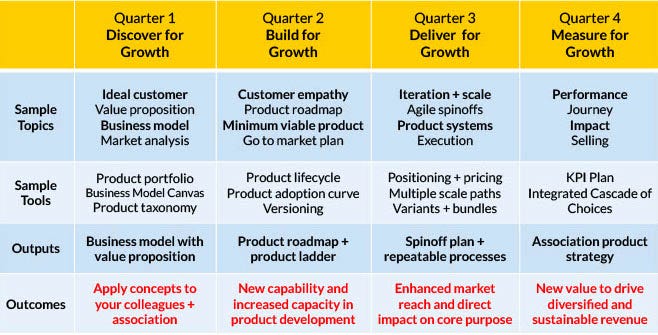Four Dimensions of Growth - New Revenue for your Association
In our last post, we addressed a multifaceted view of growth for associations. Here we dig deeper into the four dimensions of growth, which are built around the customer and serve as a key anchor for a successful product community experience.
The dimensions are intentionally designed to overlap and scaffold. They work together like a cogwheel, building upon each other as participants gain new skills while learning to build a new product. In associations, products can be as simple as a podcast or webinar or as complex as an annual conference or a piece of software.
All dimensions are anchored in an authentic concept of growth: growth in members, engagement, and reach. Discover for growth is learning about one’s current environment, understanding their market, describing members, and gaining insight into one’s culture. Build for growth applies what’s learned in the discover dimension in order to build market-ready products. Deliver for growth addresses how to get new products to market (including marketing, distribution channels, and scale) and measure for growth covers performance, selling, and storytelling.
Discover for Growth • The foundation of the product community is to gather rapid and broad input and research so you can accurately define your problem, understand your customer, and start building your culture. Understanding the problem you want to solve is paramount. It’s more important to care deeply about the problem before you fall in love with the solution. Discover for growth is about seeing patterns and recognizing possibility; it ensures your team clearly understands the customer so they can design, develop, and deliver high impact products. Discover for growth is also a deep dive into shaping a high impact culture that is diverse, cross-functional, and impactful. The outcome of this dimension is a sound value proposition and an actionable business model which are levers to the next dimension: build for growth.
Build for Growth • This dimension applies customer intelligence and market insight in order to build requirements so the team can make ideas actionable. This dimension uses road mapping and other tools to construct a product using lean innovation techniques. Lean innovation focuses on creating value and increasing efficiency by capturing customer feedback early and often and minimizing waste in the product development process. Lean innovation prioritizes experimentation elaborate planning, and celebrates continuous, incremental improvement. The outcome of this growth dimension is a full product roadmap with requirements, timelines, roles, and a financial plan. It also serves as an entree into delivery, impact, and scale.
Deliver for Growth • In the product community, products are natively designed for maximum reach. That is, they exist as part of a leverageable product portfolio. As you now put the customer at the center of all product decisions, this makes it easier to both understand and reinforce your association’s core value and core capabilities. This, in turn, makes it easier to spin off successful concepts to new markets, apply products to new segments, build effective influencer campaigns, or offer products through new delivery modalities or distribution channels. The outcome of this dimension is a channel strategy, content plan, and a growth plan built on the concept of multiple scale paths (in which a focused product is designed to be scaled in many ways).
Measure for Growth • The final dimension is a deep dive into performance and impact. How well is the product performing? Is it meeting its intended target? What metrics or key performance indicators are used to determine impact? How can data be used to change practice, bridge gaps, or enhance features? As growth in the product community is multifaceted and cultural in nature, this dimension of growth is also used to gauge how culture evolves. Tools and frameworks can help reinforce strengths and provide guidance for areas of professional growth or organizational health. The outcome of this dimension is a growth plan linked to a series of product key performance indicators (KPIs) and objectives and key results (OKRs). Though not covered in depth here, measure for growth is also instrumental in sales, storytelling, and making a sound case for making investment decisions.
Participants will leave the product community as perpetual learners who are just beginning their journey. With new capabilities, usable frameworks and tools, deeper understanding of the market, and more knowledge, participants now belong to a community that has clear, shared aspirations and is more focused on executing the future.
Throughout the experience, participants will create a common vocabulary and cover all stages of the product life cycle.
Principles of product strategy, product development, and product management will be applied to existing products using tools and frameworks through both individual and group learning.
The product community has been designed in themes upon which topics will scaffold throughout the experience. For each instructional block of the product community participants review concepts, use tools, consume and discuss reading and resources, and complete activities.
Learn more about engaging in the Product Community.
Product-led growth fuels connection. Join the product community and flip your destiny.
About the Author
James Young is founder and chief learning officer of the product community®. Jim is an engaging trainer and leading thinker in the worlds of associations, learning communities, and product development. Prior to starting the product community®, Jim served as Chief Learning Officer at both the American College of Chest Physicians and the Society of College and University Planning.
Please contact me for a conversation: james@productcommunity.us.






